In South Africa, epilepsy affects an estimated one out of every 100 people (Department of Health 2017 Fact Sheet). Neither genetic nor contagious, epilepsy is a neurological condition characterised by unusual electrical activity in the brain, resulting in seizures.
Capetonian electrical engineer and runner Mark Pikker, 34, was diagnosed with epilepsy in his early twenties, when he was in his final year of university. Many years earlier, at age 11, Mark had, unbeknownst to him, presented with early signs of epilepsy by experiencing auras, a perceptual disturbance relating to epilepsy and seizures. In Mark’s case, the auras involved the perception of a sudden increase in body heat, when there was no actual change at all in his temperature. As the auras were not followed by seizures, Mark had no reason to think anything of them – he presumed feeling uncomfortably hot at random times was perfectly normal, something everyone experienced.
Auras manifest differently from person to person. Some people experience an iodine-type smell, others might experience flickering vision, others a sense of déja vu, a loud buzzing sound, or strange multicoloured light.
In Mark’s final year of university, he was studying for his exams. He had a slight cold, and had been training hard for an ultra-distance race. Without warning, he passed out on the bathroom floor and, splitting open his chin, woke up in a pool of blood. It was his first ever seizure.
‘We consulted a neurologist, and were told I had probably just fainted from low blood pressure,’ explains Mark.
Then a week later, Mark and his mom were on their way to a training run, and Mark had a seizure in the car. Fortunately, his mom was driving.
‘It gave us both a big scare. That next week, I went for an EEG and a CT scan, but both showed nothing abnormal. The doctors assured us, however, that the scans were not conclusive – they simply reflected that my brain was functioning normally only at the time of scanning.’
Soon after that, Mark was diagnosed with epilepsy, and was prescribed medication, which managed to reduce the frequency of the auras and seizures to about four a year.
‘It was then recommended that I be tested in situ. I was taken off my meds and admitted into hospital, where I sat in bed for almost a week, with electrodes connected to my head and in full view of a video camera. The minute I would have a seizure, it would be recorded and the electrical activity in my brain measured to determine exactly where the problem was.
‘After I had the seizure, the video was replayed to my mom and I in the doctor’s room. I had never witnessed myself in that state, and when I saw how upset watching it made my mom. I realised that I couldn’t put her through that for the rest of her life. I knew I absolutely had to have the recommended brain surgery.’
But Mark also knew he was scared. The area of his brain that was malfunctioning and causing the epileptic seizures was the right temporal lobe. The temporal lobe is responsible for memory creation – there is a right and a left side, and if one part is removed, the other will take over the work load. But as with every operation, this procedure carried risk. One small mistake could see Mark paralysed for the rest of his life – a terrifying thought for anyone especially a runner.
A week before Mark went in for surgery, he underwent several hours of memory testing with neuropsychologist Elspeth Burke, and was shown to be a good candidate for the procedure.
Renowned neurosurgeon Dr Roger Melvill of Mediclinic Constantiaberg performed Mark’s surgery in a three- hour operation.
‘The side of my brain was cut open and my right temporal lobe was removed. The process sounds dramatic, and the length of the cut certainly was, but the op went smoothly, and my recuperation afterwards was fast. That was in 2010, and I’ve not experienced a seizure or an aura since. I am medication-free. The operation quite simply radically improved my life.’
Further publications on the topic
Doctors 1


